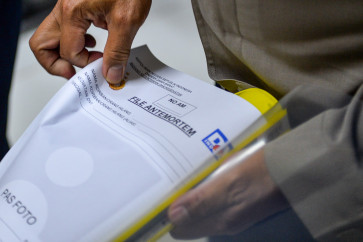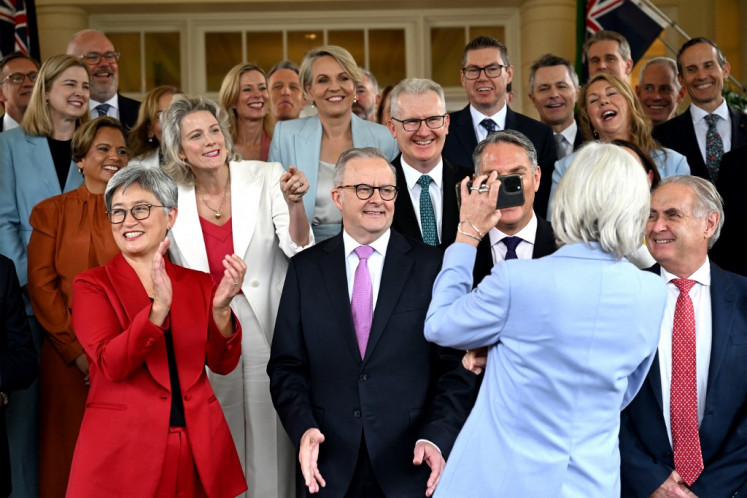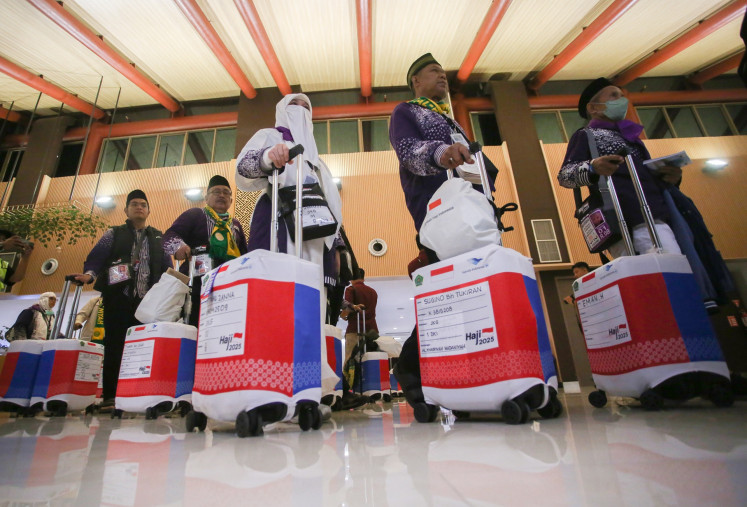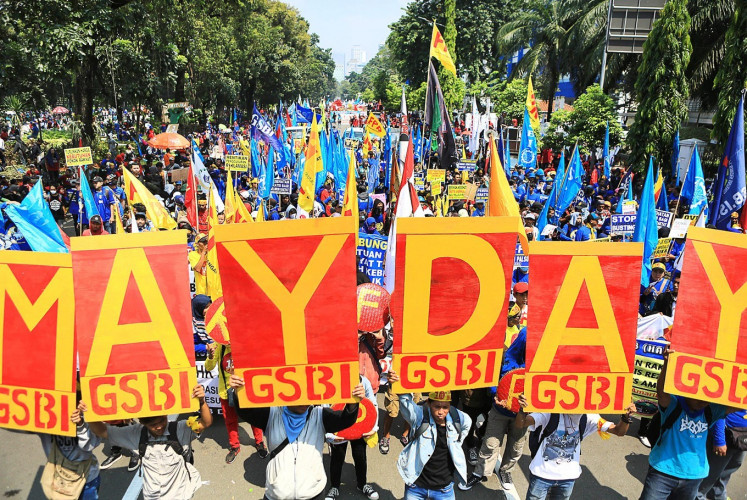'Daul' music of Madura: Born out of darknes into light
Dark music: A daul music group from Madura Island, East Java, in a modified truck decorated with colorful lights, a life-sized wooden horse and an elaborate dragon recently for the Indonesia Performing Arts Market in Jakarta
Change text size
Gift Premium Articles
to Anyone
 Dark music: A daul music group from Madura Island, East Java, in a modified truck decorated with colorful lights, a life-sized wooden horse and an elaborate dragon recently for the Indonesia Performing Arts Market in Jakarta. (Courtesy of IPAM)" border="0" height="333" width="499">Dark music: A daul music group from Madura Island, East Java, in a modified truck decorated with colorful lights, a life-sized wooden horse and an elaborate dragon recently for the Indonesia Performing Arts Market in Jakarta. (Courtesy of IPAM)
Dark music: A daul music group from Madura Island, East Java, in a modified truck decorated with colorful lights, a life-sized wooden horse and an elaborate dragon recently for the Indonesia Performing Arts Market in Jakarta. (Courtesy of IPAM)" border="0" height="333" width="499">Dark music: A daul music group from Madura Island, East Java, in a modified truck decorated with colorful lights, a life-sized wooden horse and an elaborate dragon recently for the Indonesia Performing Arts Market in Jakarta. (Courtesy of IPAM)In 1999, a blackout shrouded Madura Island in East Java, leaving its 3 million inhabitants living in darkness for months. Darkness was one thing, but without power, the population was also left without much to do.
In Pamekasan, one of the four regencies on the island, villagers used ul-daul music to serve many purposes. People toting torches created loud sounds using a bamboo instrument, locally called patrol. It served as village watch, entertainment and, in the Ramadhan fasting month, as a wake-up call. Every village had their own group and later it spread to other regencies on the island through daul competitions.
The competitions provided a fertile ground for the music to grow, and in the past few years daul music has turned into a full-fledged performing art that often manages to draw thousands of people to the streets.
Torches have been replaced with various pieces of decorative lighting, the musical instruments have expanded to include various do-it-yourself percussions, xylophones, trumpets and sometimes singing. From simple walking parades, many daul music groups create elaborate, epic floats that can measure up to 10 meters long. The songs they play have also expanded to not only Islamic and local songs but also to national hymns, English and Indonesian pop songs.
With the power back on and the musical form having evolved and spread to other regencies (except for Bangkalan), daul music has become a rich cultural phenomenon that testifies to the creative and open spirit of the people of Madura.
âThey even rap,â said Achmad Fauzi, a Pamekasan-born man who has advised many daul music groups and is also the head of the East Java Arts Council.
Fauzi recently brought one daul music group from Sumenep regency to Jakarta for Indonesia Performing Arts Market (IPAM), an event organized by the Tourism and Creative Economy Ministry to promote Indonesian performing art to overseas festival directors and art house directors.
The group brought a 13-meter float made from a modified truck and decorated with colorful lights, a life-sized wooden horse and an elaborate dragon. About 30 people manned the float â some played the music and others pushed it along down Jl. Kemang Raya on a crowded evening to open IPAM. Towering high, the float sometimes got stuck in the cityâs tangled overhead cables. The music was festive and upbeat with sounds reminiscent of a marching band.
âIn Sumenep, the daul groups were trained by a marching band coach. Hence, the trumpets,â Fauzi said.
Openness, modification and adaptation are the key to the sustainability of daul music. Over time, the artists have made innovations in percussion. There is one instrument made from a large plastic container used to breed fish. Another one was created from a large metal tub fitted with a large metal spiral inside and filled with water for better resonance. Usually, an innovation made by one group would be copied by the others. But each also brings its own trademark.
 Dark music: <)
Dark music: <)
D
span class="caption" style="width: 497px;">Dark music: A daul music group from Madura Island, East Java, in a modified truck decorated with colorful lights, a life-sized wooden horse and an elaborate dragon recently for the Indonesia Performing Arts Market in Jakarta. (Courtesy of IPAM)
In 1999, a blackout shrouded Madura Island in East Java, leaving its 3 million inhabitants living in darkness for months. Darkness was one thing, but without power, the population was also left without much to do.
In Pamekasan, one of the four regencies on the island, villagers used ul-daul music to serve many purposes. People toting torches created loud sounds using a bamboo instrument, locally called patrol. It served as village watch, entertainment and, in the Ramadhan fasting month, as a wake-up call. Every village had their own group and later it spread to other regencies on the island through daul competitions.
The competitions provided a fertile ground for the music to grow, and in the past few years daul music has turned into a full-fledged performing art that often manages to draw thousands of people to the streets.
Torches have been replaced with various pieces of decorative lighting, the musical instruments have expanded to include various do-it-yourself percussions, xylophones, trumpets and sometimes singing. From simple walking parades, many daul music groups create elaborate, epic floats that can measure up to 10 meters long. The songs they play have also expanded to not only Islamic and local songs but also to national hymns, English and Indonesian pop songs.
With the power back on and the musical form having evolved and spread to other regencies (except for Bangkalan), daul music has become a rich cultural phenomenon that testifies to the creative and open spirit of the people of Madura.
'They even rap,' said Achmad Fauzi, a Pamekasan-born man who has advised many daul music groups and is also the head of the East Java Arts Council.
Fauzi recently brought one daul music group from Sumenep regency to Jakarta for Indonesia Performing Arts Market (IPAM), an event organized by the Tourism and Creative Economy Ministry to promote Indonesian performing art to overseas festival directors and art house directors.
The group brought a 13-meter float made from a modified truck and decorated with colorful lights, a life-sized wooden horse and an elaborate dragon. About 30 people manned the float ' some played the music and others pushed it along down Jl. Kemang Raya on a crowded evening to open IPAM. Towering high, the float sometimes got stuck in the city's tangled overhead cables. The music was festive and upbeat with sounds reminiscent of a marching band.
'In Sumenep, the daul groups were trained by a marching band coach. Hence, the trumpets,' Fauzi said.
Openness, modification and adaptation are the key to the sustainability of daul music. Over time, the artists have made innovations in percussion. There is one instrument made from a large plastic container used to breed fish. Another one was created from a large metal tub fitted with a large metal spiral inside and filled with water for better resonance. Usually, an innovation made by one group would be copied by the others. But each also brings its own trademark.

'One group is comprised of members who go by boat to Bali regularly,' Fauzi said. 'They make the wooden monkey souvenirs sold to tourists. Their float was decorated with Balinese three-tiered umbrellas, the members wore the Balinese checkered sarong and the music had a Balinese sound.'
Despite its long journey, the art has continued to be the most popular entertainment form on the island because it is not afraid of modification and adaptation. 'No one screams thief. They copy, inspire each other. That's OK,' Fauzi said. 'Once the government officials scolded the Bali-inspired group for taking cultural symbols from outside. I said, let them be,' he added. 'Moreover, Bali is part of their culture because it is where they make their living.'
The communal art has thrived partly thanks to village patrons or the 'juragan' on the island. 'Juragan used to keep cows for prestige. But after the advent of daul music, they shifted to financing daul groups,' Fauzi said.
The juragan would buy the groups the instruments, the uniforms and the means to build a float. Besides preparing for the festivals, daul music groups are often hired to play at parties like weddings, Fauzi said. At weddings, they don't bring floats but only play the music.
In the past, Pamekasan, Sampang and Sumenep regencies had each organized a daul festival every year, where groups competed for prizes. But over time, only the Sumenep festival has lasted, Fauzi said. 'The cost of security has become higher. The police usually ask a lot of money to secure the streets. It is indeed a very big job for them. Thousands of people would take to the streets from the evening to the morning,' he said.
The large crowd daul draws has attracted political and business interests to organize festivals or parades. Fauzi said some of the business parties had 'poisoned' the art and exploited the daul communities. 'They told them to create jingles for the company, and they sprinkled their logos everywhere. In the end, the performers got only small fees,' he said.
'It is a form of pollution. I am not against sponsorship, but they have to respect the art and the communities, for example, by putting logos only at strategic places but not on the uniforms and the floats.'
Fauzi emphasized the need to keep daul music 'hygienic'. 'It is a true collective art, growing from a modest village festivity into a grand event,' he said. 'Such things happen only once in a blue moon.'









